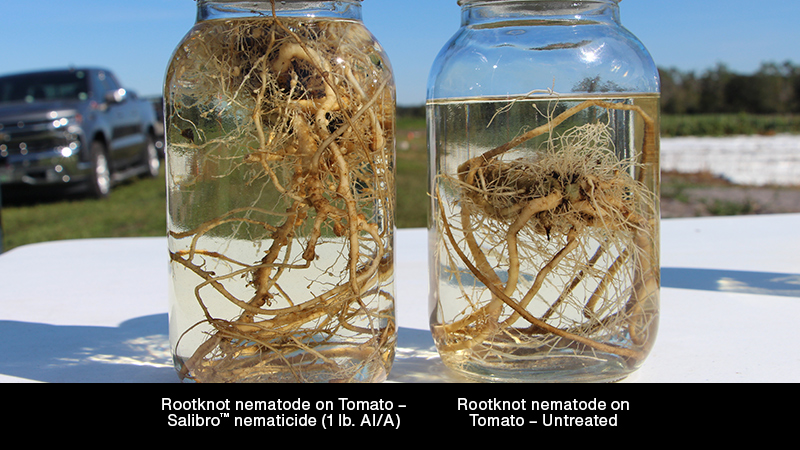The Latest Developments in Sprayer Technology for Vegetable Growers

Electronics are making the practice of spraying crops more efficient for growers. Photo courtesy of Andrew Landers
As with many agricultural tools, spray technology is evolving at a rapid rate. Growing concerns about drift, as well as the inclusion of electronics to provide detailed information about spray systems, are just a few developments taking place in the category.
Andrew Landers, Pesticide Application Technology Specialist in the Department of Entomology at Cornell University, provides insight on the most recent changes in the industry.
The Growing Use of Electronics
One of the first trends Landers notes is the use of electronic technology to provide more information about spray systems.
“For example, there’s information on the amount of spray being used, and systems that are helping the driver so they don’t have to refill their tank at the last minute. [Growers] will be able to make adjustments to the flow rate based on the information they see,” Landers says.
Most growers will spray a field and notice toward the end that they are running out of spray and have to go back and refill their tank, a practice that can become time consuming, he says.
However, with new technology available, systems will prompt growers to spray at 97% of desired application rate instead of 100%, to reduce the amount of spray used and to avoid a second refill.
Another major use of electronics Landers sees is switching off nozzles on the boom when turning at the end of a row or a headland.
“People are seeing the reduction of spray use with this. When they turn on the headland, the boom swings out and it can switch off the individual nozzles or the boom sections as you go along. It’s an impressive savings of 6% to 9%,” he explains.
An additional development Landers says has been around for a bit longer — but one that’s being adopted more widely — is the ability to electronically change the spray rate between different crops.
“If you want to change the application rate from cabbages to onions and go from 40 gallons per acre to 20 gallons per acre, the current practice is to change your forward speed if you’re on a flat farm or change nozzles. With additional technology, you could choose the desired application rate by using a manual button on an in-cab controller to adjust the flow rate for a specific crop. It saves a lot of time, and you can maintain whatever speed you want,” Landers says.
Advancements in Nozzles
The introduction of twin, flat-fanned nozzles is another key development in the spray category, according to Landers. These nozzles, which are available from most nozzle suppliers, have two, flat fan-like jets that are set at an angle and spray simultaneously.
For example, the nozzles set one fan going slightly forward at 30 degrees and then the rear facing fan points backwards at 15 degrees. This way, there are two different angles compared to a single fan, which is only vertical, Landers explains.
“Imagine an onion. If you are using a single fan, you have one chance of hitting the plant, and hitting it fairly well at that. However, if the spray was coming toward the plant at an angle, and as it passes, the rear facing fan hits the opposite side, giving us good coverage,” he explains.
Be Selective with Your Nozzles
Traditionally, growers have used one nozzle for everything, taking a one-size-fits-all approach. However, Landers cautions against this method, and suggests a more selective stance.
“For example, growers should really be using Air Induction (AI) nozzles for weed control. There has been tremendous success with this and the advantage is they reduce drift. It’s good for weeds, but still debatable whether they are useful for all applications; for example: contact insecticides,” he explains.
The droplets from the AI nozzles are larger, and provide very different coverage than you would get with the traditional flat-fan spray nozzle, which is better for insect or disease control, Landers says.
He suggests using a nozzle that produces a fine spray to be used for contact insecticides and fungicides, a medium spray to be used for systemic and translaminar fungicides and insecticides, and a coarse spray to be used for pre-emergent herbicides.
Nozzles also can be changed to help reduce drift pressure.
“Growers can reduce the droplet size with AI nozzles, and some growers I know switch to AI nozzles just on the boundaries,” he says. “The second thing would be for growers to use low-drift nozzles. However, this means you have to get off the tractor and switch the nozzles. Another thing you can do is to reduce the pressure. The lower the pressure, the bigger the droplets, and the less it will drift.”
Rinsing Tanks
Developments in tank-rinsing is another trend Landers has witnessed over the years.
“Washing out the tank is usually a chore. Sometimes you have to do it between crops because products change and you need to have a clean tank,” Landers explains.
“Traditionally, that’s done by trying to flush the tank out and wondering where it’s all going to go. However, nowadays, we have a number of manufacturers that have tank-rinsing devices, which are rotating balls that fit in the tank.”
In these cases, the rotating ball will be hooked up to a smaller tank that holds approximately 50 gallons of water, and the clean water that’s in the small tank is pumped through the rotary ball nozzle, which spins cascading the water down the main tank, Landers says.
This way, growers can rinse their sprayers in the field without being concerned about where to dispose of the chemicals.
More info on spray techniques can be found at EffectiveSpraying.com.









